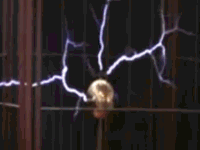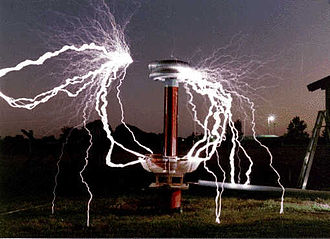

In electromagnetism, a streamer discharge, also known as filamentary discharge, is a type of transient electric discharge which forms at the surface of a conductive electrode carrying a high voltage in an insulating medium such as air. Streamers are luminous writhing branching sparks, plasma channels composed of ionized air molecules, which repeatedly strike out from the electrode into the air.
Like the related corona discharges and brush discharges, a streamer discharge represents a region around a high voltage conductor where the air has suffered electrical breakdown and become conductive (ionized), so electric charge is leaking off the electrode into the air. It occurs when the electric field at the surface of a conductor exceeds the dielectric strength of air, around 30 kilovolts per centimeter. When the electric field created by the applied voltage reaches this threshold, accelerated electrons strike air molecules with enough energy to knock other electrons off them, ionizing them, and the freed electrons go on to strike more molecules in a chain reaction. These electron avalanches (Townsend discharges) create ionized, electrically conductive regions in the air near the electrode. The space charge created by the electron avalanches gives rise to an additional electric field, causing the ionized region to grow at its ends, forming a finger-like discharge called a streamer.
Streamers are transient (exist only for a short time) and filamentary, which makes them different from corona discharges. They are used in applications such as ozone production, air purification or plasma medicine.[citation needed] If a streamer reaches the opposite polarity conductor it creates an ionized conductive path through which a large current can flow, releasing a large amount of heat, resulting in an electric arc; this is the process through which lightning leaders create a path for lightning bolts. Streamers can also be observed as sprites in the upper atmosphere. Due to the low pressure, sprites are much larger than streamers at ground pressure, see the similarity laws below.

